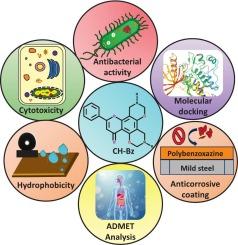一个特殊的分子框架:双功能苯并恶嗪从可再生的菊花素抗菌,低毒性,分子对接研究可持续的多方面应用
IF 6.3
2区 化学
Q1 POLYMER SCIENCE
引用次数: 0
摘要
以可再生菊花素为前体,合成了两个系列的双功能苯并恶嗪,其中既有合成胺源,也有生物胺源。通过红外傅立叶变换(FTIR)、核磁共振(NMR)和高分辨质谱(HRMS)对合成的苯并恶嗪单体进行了结构验证。CH-pga和CH-ffa的最低聚合温度为193℃。生物基苯并恶嗪具有比合成胺取代苯并恶嗪更低的聚合温度。相反,合成胺取代的聚苯并恶嗪的热稳定性优于生物基的聚苯并恶嗪。Poly(CH-pga)在850°C时表现出最高的热稳定性,炭收率为39%,理论计算的极限氧指数(LOI)和耐热指数(HRI)值最高。CH-oda对金黄色葡萄球菌和大肠杆菌的抑菌活性分别为55%和90%。与其他单体相比,CH-oda对L929细胞株毒性最小,IC50值最高,为171µg/mL。聚(CH-oda)的最高水接触角为143°,缓蚀效率为99.89%,密度泛函理论(DFT)进一步验证了这一点。从分子对接来看,CH-a与表皮生长因子受体(eGFR)的对接评分和结合亲和力最高,具有较高的抗癌活性。所有苯并恶嗪类药物的吸收、分布、代谢、排泄和毒性(ADMET)指标均满足要求,显示出药物的可能性。因此,从目前的研究实验数据来看,与合成胺基苯并恶嗪相比,生物基苯并恶嗪具有更好的疏水性、防腐性能、抗菌活性和低毒性。然而,根据对接研究,这两个苯并恶嗪系列都表现出良好的抗癌和药物可能性。本文章由计算机程序翻译,如有差异,请以英文原文为准。

A privileged molecular framework: Bifunctional benzoxazines from renewable chrysin for antimicrobial, low toxicity, molecular docking studies for sustainable multifaceted applications
Two series of bifunctional benzoxazines were synthesized using renewable chrysin as a precursor, incorporating both synthetic and bio-based amine sources. The synthesized benzoxazine monomers were structurally validated through Fourier transform infrared (FTIR), 1H-nuclear magnetic resonance (NMR) and high resolution mass (HRMS) spectral analyses. The lowest polymerization temperature of 193 °C was observed in CH-pga and CH-ffa. The bio-based benzoxazines possessed lower polymerization temperature than synthetic amine substituted benzoxazines. In contrary, the thermal stability of the synthetic amine substituted polybenzoxazines was found to be greater than that of bio-based polybenzoxazines. Poly(CH-pga) showed highest thermal stability with a char yield of 39 % at 850 °C exhibiting highest theoretically calculated limiting oxygen index (LOI) and heat resistance index (HRI) values. CH-oda possessed highest antimicrobial activity of 55 % and 90 % bacterial growth inhibition against S.aureus and E.coli respectively. CH-oda showed least toxicity towards L929 cell line showing highest IC50 value of 171 µg/mL when compared to rest of the monomers. Poly(CH-oda) exhibited highest water contact angle of 143° and corrosion inhibition efficiency of 99.89 % which was further validated by density functional theory (DFT) studies. From the molecular docking, CH-a showed the best docking score and binding affinity to the epidermal growth factor receptor (eGFR) ascertaining the presence of higher anticancer activity. Also, the absorption, distribution, metabolism, excretion and toxicity (ADMET) parameters have been satisfied by all the benzoxazines showing drug likeliness. Therefore, from the current study experimental data suggests that bio-based benzoxazines possess better hydrophobicity, anticorrosion property, antimicrobial activity and low toxicity when compared to synthetic amine based benzoxazines. Whereas, both the series of benzoxazines exhibit good anticancer and drug likeliness property as per docking studies.
求助全文
通过发布文献求助,成功后即可免费获取论文全文。
去求助
来源期刊

European Polymer Journal
化学-高分子科学
CiteScore
9.90
自引率
10.00%
发文量
691
审稿时长
23 days
期刊介绍:
European Polymer Journal is dedicated to publishing work on fundamental and applied polymer chemistry and macromolecular materials. The journal covers all aspects of polymer synthesis, including polymerization mechanisms and chemical functional transformations, with a focus on novel polymers and the relationships between molecular structure and polymer properties. In addition, we welcome submissions on bio-based or renewable polymers, stimuli-responsive systems and polymer bio-hybrids. European Polymer Journal also publishes research on the biomedical application of polymers, including drug delivery and regenerative medicine. The main scope is covered but not limited to the following core research areas:
Polymer synthesis and functionalization
• Novel synthetic routes for polymerization, functional modification, controlled/living polymerization and precision polymers.
Stimuli-responsive polymers
• Including shape memory and self-healing polymers.
Supramolecular polymers and self-assembly
• Molecular recognition and higher order polymer structures.
Renewable and sustainable polymers
• Bio-based, biodegradable and anti-microbial polymers and polymeric bio-nanocomposites.
Polymers at interfaces and surfaces
• Chemistry and engineering of surfaces with biological relevance, including patterning, antifouling polymers and polymers for membrane applications.
Biomedical applications and nanomedicine
• Polymers for regenerative medicine, drug delivery molecular release and gene therapy
The scope of European Polymer Journal no longer includes Polymer Physics.
 求助内容:
求助内容: 应助结果提醒方式:
应助结果提醒方式:


